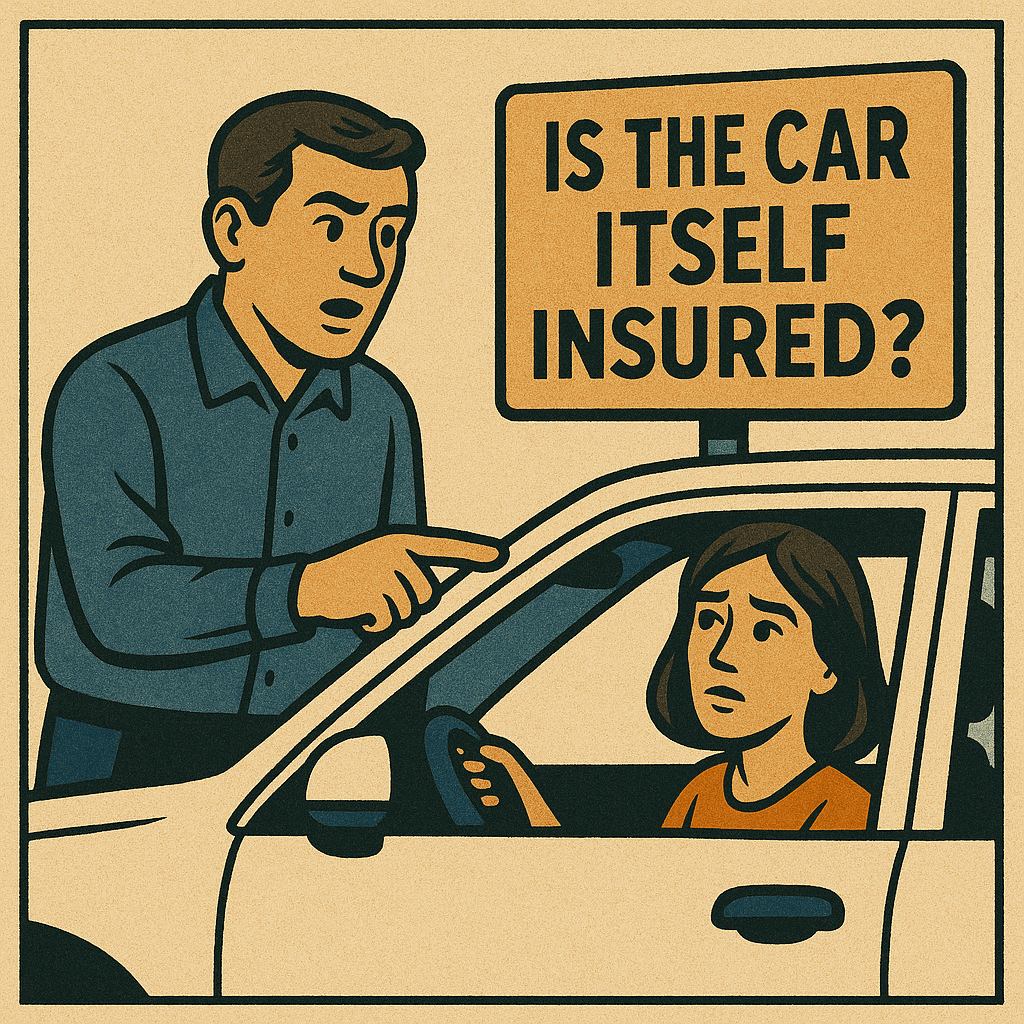Not usually. In the UK, it’s illegal to drive without insurance. Someone can only drive your car if they’re insured to drive that specific vehicle — for example, by being added as a named driver, buying temporary car insurance, or (less commonly) the policyholder’s policy includes a “driving other cars” (DOC) extension. Driving without the right cover can mean a £300 fixed penalty, 6 points, vehicle seizure, and even court action.

What “driving other cars (DOC)” really means (and why you shouldn’t rely on it)
DOC is an add-on that some insurers include for the policyholder (not named drivers). Where it exists, it typically provides third-party only cover to drive another person’s car, with their permission. That means if you crash the borrowed car, your damage isn’t covered — only third-party injury/damage is. DOC used to be common; it’s now far less widespread, and you must check your certificate/policy wording before you drive.
Insurers also place conditions. Examples from big UK insurers include:
Age limits (often 25+).
Only for the policyholder, not named drivers.
The car can’t be owned by you or rented to you, and you must have the owner’s permission.
Even when DOC exists, cover is usually third-party only.
Because rules vary and DOC is rarer than it used to be, don’t assume you have it. Check Section 5 of your motor insurance certificate or your policy documents.
Safer, clearer options than DOC
1) Add them as a named driver
Adding someone as a named driver on your policy ensures they can drive your car with the same cover level (e.g., comprehensive). If a claim is made while they’re driving, it’s your policy that’s used — and your no-claims discount may be affected. Premium impact can go up or down depending on the driver (e.g., adding an experienced driver to a young driver’s policy can lower costs; adding a young/inexperienced driver to an older driver’s policy can raise them). Never misrepresent the main driver — “fronting” is insurance fraud.
2) Buy temporary (short-term) car insurance
Short-term policies (from 1 hour to 30 days, depending on provider) insure the borrower on your car as a separate policy, often at a comprehensive level. Crucially, if they claim on their temporary policy, it doesn’t touch your no-claims bonus on your annual policy. This is the cleanest option for occasional use.
“Is the car itself insured?” — why that matters (but isn’t enough)
Every car used on UK roads must be insured (or SORN off-road). You — or they — can check if a vehicle is on the Motor Insurance Database (MID) via Navigate/askMID using the reg number. But note: a car showing as insured doesn’t mean the driver is insured to drive it. The right driver-specific cover must still be in place.
Common scenarios (and what’s legal)
“My partner wants to drive my car.”
Best: add them as a named driver or get temporary cover. Don’t rely on DOC — many policies exclude using DOC to drive a spouse/partner’s car, and it’s often third-party only anyway.
“My mate needs to borrow my car for an errand.”
Best: temporary cover in their name, or add them as a named driver if it’s ongoing. DOC might not exist on their policy; even if it does, it’s usually third-party only.
“Emergency — I need to drive someone home in their car.”
You still need valid insurance for that car (DOC on your policy, or temporary cover, or being named). Police can and do penalise uninsured driving, even in “emergencies.”
“I have full comp on my car — that means I can drive any car, right?”
Wrong. Fully comprehensive doesn’t automatically include DOC. Many insurers have removed or restricted it. Always check your certificate/policy.
The risk of getting this wrong
If someone drives your car without the right insurance (and without being properly covered themselves), they’re committing an offence. Penalties include a £300 fixed penalty, 6 points, police seizure (and possible destruction) of the vehicle; courts can impose an unlimited fine and disqualification. As the owner, you could also find yourself on the hook for third-party costs if an uninsured driver causes an accident.
How to let someone else drive your car (safely) — a 3-step check
Decide the cover route:
One-off/short term? Buy temporary insurance in their name.
Regular use? Add as a named driver.
Never assume DOC. If relying on it, confirm on your certificate.
Permission & eligibility:
The owner must give permission; the borrower must meet age/eligibility rules in the policy (DOC often 25+ and policyholder-only).
Sanity checks: Ensure the vehicle shows insured on the MID (Navigate/askMID) and keep policy proof accessible (digital or paper). Remember: MID confirms the car’s insurance record, not the driver’s.
Quick FAQs
Can a named driver use my car as much as they like?
They can drive it, but you must remain the main driver if the policy is in your name. Making a frequent user a “named driver” while you rarely drive is fronting, which is fraud.
Does a named driver’s accident affect my No-Claims Discount?
If a claim is made on your policy (regardless of who was driving), your NCD can be affected. Temporary policies avoid this by sitting separately.
Is DOC ever comprehensive?
Occasionally, some insurers/markets reference comprehensive DOC, but in the UK, it’s commonly third-party only and tightly restricted. Always check your insurer’s wording.
Does DOC cover my partner’s car?
Often, many insurers exclude spouses/partners’ cars from DOC unless stated. Safer to be named or use a temporary cover.
What are the official penalties for uninsured driving?
£300 fixed penalty + 6 points, vehicle seizure, and possible court with unlimited fines/disqualification.
